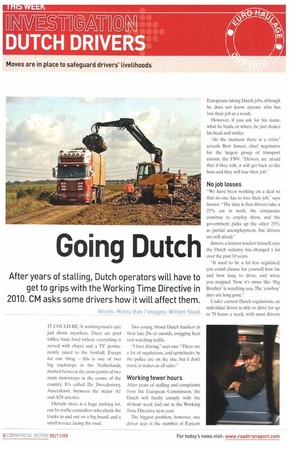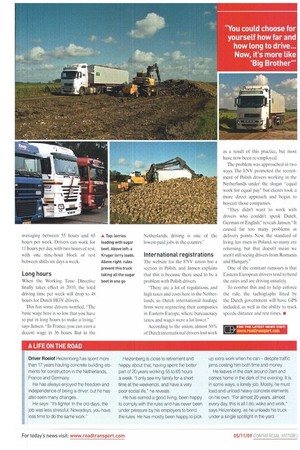Going Dutch
Page 20

Page 21

If you've noticed an error in this article please click here to report it so we can fix it.
After years of stalling, Dutch operators will have to get to grips with the Working Time Directive in 2010. CM asks some drivers how it will affect them.
Words: Mindy Ran / Images: Willem Staat IT COULD BE A working-man's cafe just about anywhere. There are pool tables, basic food (where everything is served with chips) and a TV permanently tuned to the football. Except for one thing this is one of two big truckstops in the Netherlands, nestled between the cross-points of two main motorways in the centre of the country. It's called De Tweedesteeg, Amersfoort, between the major Al and A28 arteries.
Outside there is a huge parking lot, run by traffic controllers who check the trucks in and out on a big board, and a small terrace facing the road. Two young, blond Dutch hauliers in their late 20s sit outside, swigging beer and watching traffic.
"I love driving," says one. "There are a lot of regulations, and spotchecks by the police are on the rise, but I don't mind, it makes us all safer."
Working fewer hours
After years of stalling and complaints from the European Commission, the Dutch will finally comply with the 48-hour week laid out in the Working Time Directive next year.
The biggest problem, however, one driver sees is the number of Eastern Europeans taking Dutch jobs, although he does not know anyone who has lost their job as a result.
However, if you ask for his name. what he hauls, or where, he just shakes his head and smiles.
"At the moment there is a crisis," reveals Bert Jansen, chief negotiator for the largest group of transport unions, the ENV. -Drivers are afraid that if they talk, it will get back to the boss and they will lose their job.
No job losses
"We have been working on a deal so that no one has to lose their job," says Jansen. "The idea is that drivers take a 25% cut in work, the companies continue to employ them, and the government picks up the other 25% as partial unemployment, but drivers are still afraid."
Jansen, a former trucker himself, says the Dutch industry has changed a lot over the past 10 years.
"It used to be a lot less regulated; you could choose for yourself how far and how long to drive, and when you stopped. Now, it's more like 'Big Brother' is watching you. The 'cowboy' days are long gone."
Under current Dutch regulations. an individual driver is able to drive for up to 70 hours a week, with most drivers averaging between 55 hours and 65 hours per week. Drivers can work for 11 hours per day, with two hours of rest, with one nine-hour block of rest between shifts six days a week.
Long hours
When the Working Time Directive finally takes effect in 2010, the total driving time per week will drop to 48 hours for Dutch HGV drivers.
This has some drivers worried. "The basic wage here is so low that you have to put in long hours to make a living," says Jansen. "In France, you can earn a decent wage in 36 hours. But in the Netherlands, driving is one of the lowest-paid jobs in the country."
International registrations
The website for the FNV union has a section in Polish, and Jansen explains that this is because there used to be a problem with Polish drivers.
"There are a lot of regulations, and high taxes and costs here in the Netherlands, so Dutch international haulage firms were registering their companies in Eastern Europe, where bureaucracy taxes, and wages were a lot lower."
According to the union, almost 50% of Dutch international drivers lost work as a result of this practice, but most have now been re-employed.
The problem was approached in two ways. The FNV promoted the recruitment of Polish drivers working in the Netherlands under the slogan "equal work for equal pay" but clients took a more direct approach and began to boycott those companies.
"They didn't want to work with drivers who couldn't speak Dutch, German or English," reveals Jansen. "It caused far too many problems at delivery points. Now, the standard of Living has risen in Poland, so many are returning, but that doesn't mean we aren't still seeing drivers from Romania and Hungary."
One of the constant rumours is that Eastern European drivers tend to bend the rules and are driving unsafely.
To combat this and to help enforce the rule, the tachographs fitted by the Dutch government will have GPS included, as well as the ability to track speeds, distance and rest times. •
















































































































































